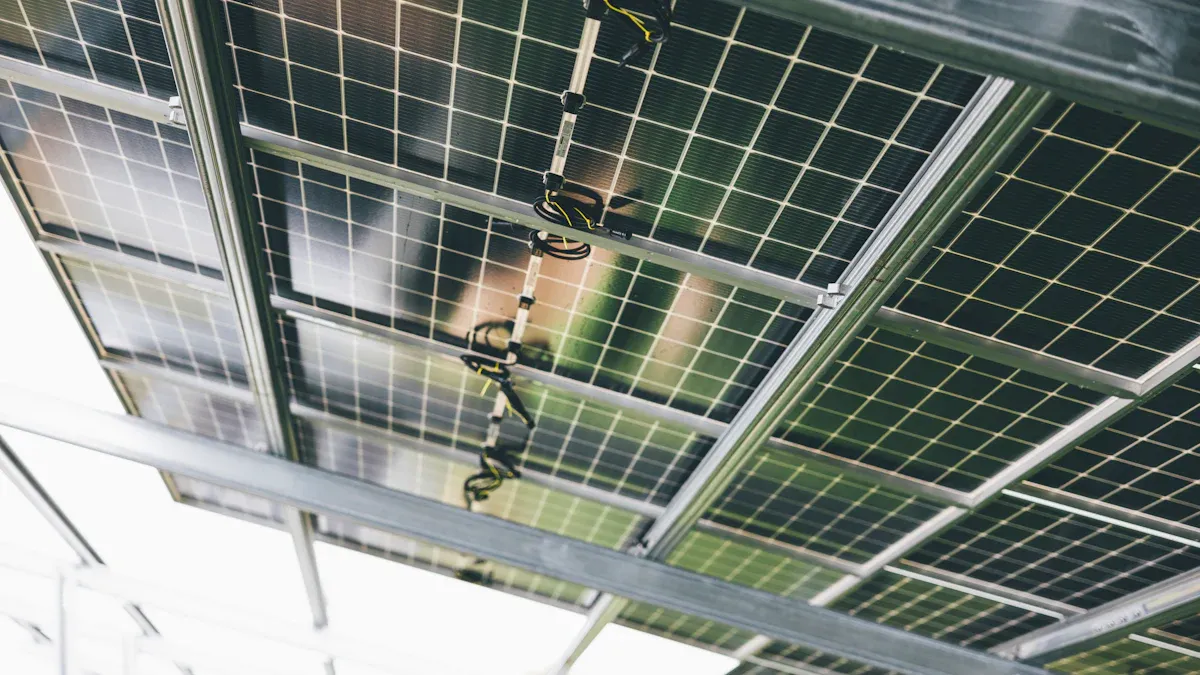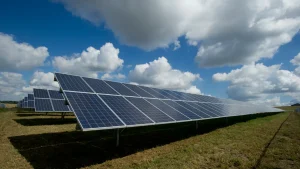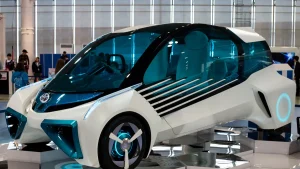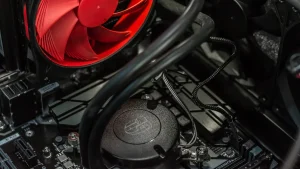
Chemical Vapor Deposition (CVD) coating has revolutionized photovoltaic manufacturing by enabling advanced material engineering, particularly through Tecnologia de revestimento DCV TaC. This technology facilitates the deposition of thin films with exceptional conformity and material properties, which are critical for enhancing solar cell performance. Its integration with automation ensures consistent coating quality, reducing production costs and material waste. Innovations like low-temperature deposition and plasma-enhanced techniques expand its applications, making solar technology more efficient and durable. As a result, Revestimento de DCV plays a pivotal role in improving light absorption, protecting surfaces, and optimizing multi-junction solar cells, thereby driving the TAC coatings market forward and showcasing the potential of Tecnologia de revestimento TAC.
Tiras de Chaves
- CVD coating helps solar cells work better by trapping more light and wasting less energy.
- Anti-reflective coatings cut down light bouncing off by 25%, making energy conversion 12% better.
- CVD layers protect surfaces, stopping energy loss and improving efficiency by 20%.
- Strong CVD layers protect solar panels from weather, making them last longer.
- CVD coating helps create light and bendable solar cells, making solar power easier to use.
Enhancing Light Absorption with CVD Anti-Reflective Coatings

Reducing Reflection Loss for Maximum Energy Capture
CVD anti-reflective coatings play a crucial role in minimizing reflection losses, ensuring that more sunlight penetrates the photovoltaic absorber. By reducing the amount of light reflected off the surface, these coatings maximize energy capture, which directly impacts the overall efficiency of solar cells. Advanced techniques, such as destructive interference and refractive-index matching, are employed to achieve this reduction. Studies have shown that these methods can decrease reflection losses by up to 25%, leading to a 12% increase in energy conversion efficiency.
Nature-inspired designs, like nipple-array surface architectures, further enhance the effectiveness of anti-reflective coatings. These structures mimic natural patterns to optimize light transmission. For instance, a system utilizing bifacial panels and high-albedo materials demonstrated significant improvements in energy yield. This setup allowed the panels to capture both direct and reflected sunlight, showcasing the potential of CVD Coating in advancing solar technology.
Boosting Solar Cell Efficiency with Improved Light Absorption
Improved light absorption is critical for enhancing the performance of solar cells. CVD Coating technologies enable the deposition of ultra-thin, uniform layers that enhance the optical properties of photovoltaic materials. For example, applying amorphous carbon nitride (CNx) coatings on crystalline silicon solar cells resulted in remarkable efficiency gains. The external quantum efficiency increased from 46% to 98%, while the photoelectric conversion efficiency rose from 5.52% to 13.05%. These improvements highlight the transformative impact of CVD Coating on solar cell performance.
Another case involved the application of a titanium dioxide (TiO2) layer on CNT-Si cells. This coating boosted efficiency from 8% to 14.5%, with a 30% increase in short-circuit current density. Such advancements underscore the importance of precise thin-film deposition in optimizing light absorption. By leveraging these innovations, manufacturers can produce solar cells with higher energy output and improved reliability.
Advancing Surface Passivation with CVD Coating
Minimizing Recombination Losses for Higher Energy Output
Surface passivation plays a critical role in reducing recombination losses in solar cells. Recombination occurs when electrons and holes, generated by sunlight, recombine before contributing to the electrical current. This process reduces the energy output of solar cells. DCV Revestimento offers a precise and effective solution for addressing this challenge. By depositing ultra-thin passivation layers, it minimizes surface defects that act as recombination centers.
For instance, silicon nitride (SiNx) layers applied through CVD Coating have demonstrated exceptional passivation properties. These layers create a barrier that reduces electron-hole recombination, leading to higher energy conversion efficiency. Studies reveal that solar cells with optimized passivation layers can achieve efficiency improvements of up to 20%. This advancement underscores the importance of surface passivation in maximizing the performance of photovoltaic systems.
Enhancing Long-Term Performance of Solar Cells
The durability of solar cells significantly impacts their long-term performance. Environmental factors, such as moisture, UV radiation, and temperature fluctuations, can degrade the surface of photovoltaic materials over time. CVD Coating enhances the resilience of solar cells by forming robust passivation layers that protect against these stressors.
Aluminum oxide (Al2O3) coatings, applied using CVD technology, have proven effective in maintaining the stability of solar cells. These coatings provide excellent chemical and thermal stability, ensuring consistent performance over extended periods. Additionally, the uniformity of CVD-applied layers prevents microcracks and other structural defects, further extending the lifespan of solar panels. By improving both efficiency and durability, surface passivation with CVD Coating contributes to the reliability and sustainability of solar energy systems.
Strengthening Solar Panels with Durable CVD Protective Layers

Increasing Resistance to Environmental Stressors
Solar panels face constant exposure to harsh environmental conditions, including heat, moisture, and UV radiation. These stressors can degrade their performance over time. Durable protective layers applied through CVD Coating provide a robust solution to this challenge. These coatings form a uniform, defect-free barrier that shields the panels from external damage. By enhancing the surface’s resistance to environmental factors, they ensure consistent energy output even in extreme conditions.
The new amidinium-based protective coating significantly enhances the stability and performance of perovskite solar cells, making them 10 times more resistant to decomposition than traditional coatings. This advancement triples the T90 lifetime of the cells, addressing critical stability issues under environmental stressors like heat and moisture.
This breakthrough demonstrates the transformative potential of advanced CVD-applied protective layers. By incorporating such innovations, manufacturers can produce solar panels that maintain their efficiency and reliability in diverse climates.
Extending the Lifespan of Solar Panels
The longevity of solar panels directly impacts their cost-effectiveness and sustainability. Protective layers created using CVD Coating technology play a vital role in extending their operational lifespan. These coatings prevent the formation of microcracks and other structural defects that can compromise the panels’ integrity. Additionally, they offer excellent chemical and thermal stability, reducing the risk of degradation caused by prolonged exposure to environmental elements.
For instance, aluminum oxide coatings applied through CVD technology have shown remarkable durability. These layers not only protect the panels from physical damage but also preserve their electrical properties over time. By minimizing wear and tear, CVD-applied protective layers help solar panels achieve optimal performance throughout their lifecycle. This advancement supports the broader adoption of solar energy by reducing maintenance costs and enhancing long-term reliability.
Supporting Thin-Film Solar Technologies with CVD Coating
Enabling Precise Thin-Film Deposition
Thin-film solar technologies rely on the accurate deposition of materials to achieve optimal performance. CVD Coating, particularly Plasma Enhanced Chemical Vapor Deposition (PECVD), provides a highly effective solution for this requirement. PECVD enables low-temperature deposition, making it suitable for temperature-sensitive substrates commonly used in thin-film solar cells. This capability ensures that delicate materials remain intact during the coating process.
The precision of PECVD allows manufacturers to control the thickness and composition of thin films with remarkable accuracy. This control enhances the efficiency of solar cells by improving charge carrier lifetimes and reducing light reflection. For example, thin films deposited using PECVD exhibit uniformity that minimizes defects, leading to better energy conversion rates. These advancements highlight the critical role of precise deposition in supporting the development of high-performance thin-film solar technologies.
Advantages of Lightweight and Flexible Solar Cells
Thin-film solar cells offer unique advantages due to their lightweight and flexible nature. These characteristics make them ideal for applications where traditional rigid panels are impractical, such as on curved surfaces or portable devices. The integration of CVD-applied coatings further enhances these benefits by providing robust protection without adding significant weight.
The flexibility of thin-film solar cells, combined with the durability of CVD-applied layers, opens up new possibilities for solar energy deployment. For instance, these cells can be incorporated into building materials, such as windows or facades, to create energy-generating structures. Additionally, their lightweight design reduces transportation and installation costs, making solar energy more accessible. By leveraging the advantages of thin-film technologies, manufacturers can expand the reach of renewable energy solutions.
Optimizing Multi-Junction Solar Cells with CVD Coating
Facilitating Layered Structures for Enhanced Energy Conversion
Multi-junction solar cells rely on layered structures to capture a broader spectrum of sunlight. Each layer targets specific wavelengths, maximizing energy conversion. CVD Coating plays a pivotal role in fabricating these layers with precision and uniformity. By enabling the deposition of ultra-thin films, it ensures seamless integration between layers, reducing energy losses at interfaces.
Research highlights the effectiveness of CVD techniques in creating high-quality films. For instance, a one-step CVD method has been shown to produce perovskite materials with large grain sizes and high surface coverage. These characteristics are essential for enhancing the efficiency of multi-junction solar cells. Optimizing CVD parameters, such as temperature and deposition rate, further improves film quality, leading to higher power conversion efficiencies.
The technical advancements in CVD Coating are supported by various studies. The table below showcases notable research efforts:
| Estudo | Designação das mercadorias | Link |
|---|---|---|
| Tu et al. (2006) | A novel method for growing polycrystalline Ge layer using UHVCVD. | Link |
| Uhlmann and Koenig (2009) | CVD diamond coatings on geometrically complex cutting tools. | Link |
| Dobrzański et al. (2010) | Structure and properties of PVD and CVD coatings on sintered cutting tools. | Link |
These studies demonstrate the versatility of CVD Coating in facilitating layered structures, making it indispensable for multi-junction solar cell development.
Unlocking the Potential of Multi-Junction Solar Cells
Multi-junction solar cells offer unparalleled efficiency by combining multiple layers, each optimized for specific light wavelengths. CVD Coating enhances this potential by delivering precise control over material properties. This precision allows manufacturers to fine-tune the bandgap of each layer, ensuring maximum energy absorption.
The ability of CVD Coating to produce defect-free films is another critical advantage. Defects can disrupt electron flow, reducing efficiency. By minimizing imperfections, CVD-applied layers improve charge carrier mobility, leading to higher energy output. Furthermore, the scalability of CVD processes supports the mass production of multi-junction solar cells, making them more accessible for commercial applications.
These advancements position multi-junction solar cells as a cornerstone of next-generation solar technology. With the support of CVD Coating, they can achieve efficiencies exceeding 40%, unlocking new possibilities for renewable energy systems.
DCV Revestimento has transformed photovoltaic manufacturing by enabling precise material engineering and enhancing solar cell performance. Its applications, from anti-reflective coatings to multi-junction solar cells, have significantly advanced solar technology. These innovations promise a future where solar energy becomes more efficient, durable, and accessible.
A advancements in semitransparent solar cells, PECVD efficacy, and encapsulation techniques underscore the transformative potential of CVD Coating. The table below highlights key findings:
| Principais conclusões | Designação das mercadorias |
|---|---|
| Advancements in Semitransparent Solar Cells | Significant progress in polymer, perovskite, and silicon-based technologies. |
| Efficacy of PECVD | Enhanced performance in monolithic perovskite/Si tandem solar cells. |
| Recommendations for Improvement | Emphasis on encapsulation and stringent PECVD parameter control. |
Ningbo VET Energy Technology Co. continues to drive innovation in CVD coating technologies, contributing to the evolution of renewable energy solutions.
FAQ
What is the primary role of CVD coating in photovoltaic manufacturing?
CVD coating enhances solar cell performance by improving light absorption, reducing energy losses, and increasing durability. It enables precise material deposition, ensuring uniformity and efficiency in photovoltaic systems.
How does CVD coating improve solar panel durability?
CVD-applied protective layers shield solar panels from environmental stressors like UV radiation, moisture, and temperature fluctuations. These coatings prevent microcracks and structural damage, extending the panels’ lifespan.
Why is surface passivation important in solar cells?
Surface passivation minimizes recombination losses by reducing defects on the solar cell surface. This process increases energy output and ensures long-term performance stability.
Can CVD coating support flexible solar technologies?
Sim, CVD coating enables precise thin-film deposition, making it ideal for lightweight and flexible solar cells. These cells are suitable for curved surfaces, portable devices, and building-integrated photovoltaics.
What makes multi-junction solar cells more efficient?
Multi-junction solar cells use layered structures to capture a broader spectrum of sunlight. CVD coating ensures precise layer deposition, reducing energy losses and enhancing overall efficiency.






